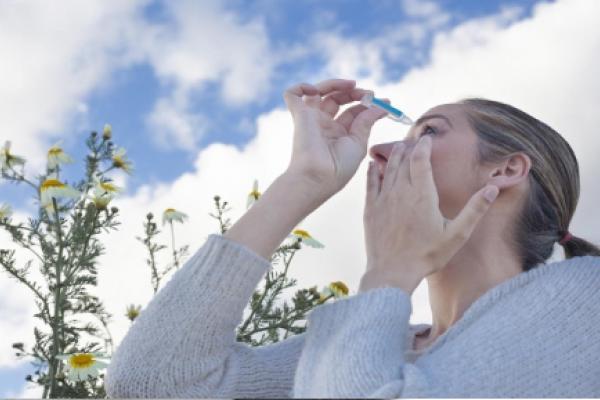Stating that "Allergic conjunctivitis", which manifests itself with redness, watering, and itching of the eyes, is a very common eye disease, Yeditepe University Hospitals Ophthalmologist Prof. Dr. Sinan Tatlıpınar gave information on the subject. He said, "We usually use combined treatments in the treatment of allergic conjunctivitis, but the basic principle is to stay away from the factor that causes allergies."
What is Allergic Conjunctivitis (Eye Allergy)?
Yeditepe University Hospitals Ophthalmologist Prof. Dr. Sinan Tatlıpınar, who stated that allergic conjunctivitis, which manifests itself with redness, watering, and itching of the eyes, is a very common eye disease, defines allergic conjunctivitis as “an allergy-induced inflammation of the membrane called the conjunctiva, which surrounds the inner part of the eyelids and the white part of the eye.”
Stating that allergic diseases of the eye are common, Dr. Tatlıpınar said, “In fact, allergic conjunctivitis is a general term describing a group of diseases. Its subtypes include seasonal allergic conjunctivitis, perennial allergic conjunctivitis (long-term allergic conjunctivitis), vernal keratoconjunctivitis, atopic keratoconjunctivitis, and giant papillary conjunctivitis.”
Emphasizing that allergic conjunctivitis usually affects both eyes together, Dr. Tatlıpınar lists other symptoms as follows: “Itching and redness in the eyes, burning sensation in the eyes, swelling of the eyelids, watering in the eyes are general symptoms. However, these symptoms may vary depending on the type. In advanced cases, if the transparent layer (cornea) is affected, it may cause vision problems.” Stating that the diagnosis of allergic conjunctivitis is made with the patient's complaints, a careful examination, and some laboratory examinations, Prof. Dr. Sinan Tatlıpınar made the following statements about the treatment: “The principle in the treatment of allergic conjunctivitis is to stay away from the cause of the allergy if we know it. Often combined treatments are used. Depending on the type and severity of the disease, antihistamine drops, and cortisone-containing medications are used, when necessary, under the supervision of a doctor.”
Subtypes of Conjunctivitis
Seasonal and Perennial Allergic Conjunctivitis
These two types of allergies can be grouped. In both types, an allergy develops against a specific agent in the air. Seasonal allergic conjunctivitis is the most common allergic eye disease. Approximately half of all allergic conjunctivitis cases are in this group. The factor here is often pollen. Bilateral lacrimation, itching, burning sensation, and redness are seen. Eyelids may be slightly swollen, but vision is normal. It is often accompanied by signs of allergic rhinitis such as runny nose, sneezing, nasal congestion, and itching. Perennial, i.e. long-term allergic conjunctivitis, is present throughout the year and house dust and animal waste are mainly responsible for this type. This type is less common and usually occurs less severely than the seasonal type.
Vernal keratoconjunctivitis (Spring Keratoconjunctivitis)
It is a type of allergic conjunctivitis that affects children and young adults. It is more common and severe in warm and dry climates. It is more common in men. Its onset is usually after the age of 5, and the disease usually ends by the age of puberty. The duration of the disease rarely exceeds 5-10 years. It is typically seasonal and lasts from spring to late summer.
Atopic Keratoconjunctivitis
It is a form of allergic conjunctivitis with the highest risk of blindness. It is observed rarely and in young people. It begins around the twenties and continues for many years. Atopy is an inherited and structural feature that causes a person to develop an allergic disorder. This type of conjunctivitis is seen in people with atopy symptoms such as asthma, rhinitis, atopic dermatitis, and food allergy. Ocular findings usually develop a few years after the appearance of other atopic findings and are similar to vernal keratoconjunctivitis. The eyelids are often involved. The lid skin is red, thickened, and flaky. Eyelash root inflammation is common. Adhesions in the inner parts of the lid, abnormal vascularization in the cornea layer of the eye, and cataracts can be seen.
Giant Papillary Conjunctivitis
This disease can develop against contact lenses, contact lens cleaning, or care products. There are bumps called papillae in the conjunctiva that covers the bottom of the upper lid. Patients complain that they feel uncomfortable when they wear contact lenses. Sometimes eye prostheses and stitches placed on the eye can also create this picture. In the treatment, the factor causing this picture should be eliminated and anti-allergic medications should be used.
Sometimes, an allergic reaction may occur in the eye against the medications used in the eyes, the preservatives in these medications, or the cosmetic substances.
What Causes Watering Eyes and Runny Nose?
Hay fever, which develops as a result of genetic and environmental factors and occurs as a hypersensitivity reaction, is a disease that is characterized by a runny nose, nasal itching, frequent sneezing, nasal congestion, lacrimation, and olfactory disorder, which seriously reduces the quality of life of patients.
What Causes Eye and Eyelid Itching?
When there is itching and redness in the eyes, the person makes many applications to relieve the irritation and relax. However, knowing the cause of itching is important for faster relief with the right treatment.
How Is Eye Dryness Treated?
Since eye dryness is quite common due to today's lifestyle, one of the most frequently asked questions is what to do for eye dryness. Avoiding air currents caused by air conditioners and fans, especially in summer months, prevents eye dryness.
”







